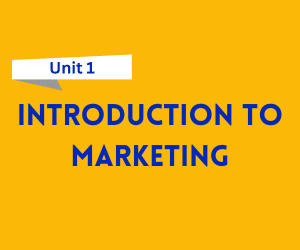Marketing plays a vital role in connecting businesses with their customers by identifying needs, developing suitable products or services, and delivering them efficiently. This unit introduces the foundational concepts of marketing, the evolution of marketing practices, and the dynamic environment in which marketing operates. Understanding these basics helps future managers make better decisions in product development, customer engagement, and competitive positioning.

Download Unit 1 – Introduction to Marketing, Marketing Mix and Environment Notes
Get simplified revision notes for this unit:
Download Unit 1 Notes PDF
(a) Introduction to Marketing, Marketing Mix, and Evolution
Meaning, Nature, Scope, and Importance of Marketing
Marketing is a social and managerial process through which individuals and organizations obtain what they need and want by creating and exchanging value. It involves identifying customer needs, developing suitable products, and delivering them efficiently. The nature of marketing is dynamic, customer-centric, and ever-evolving. The scope of marketing extends beyond selling; it includes research, pricing, promotion, distribution, and after-sales services. Marketing is important for driving business growth, enhancing brand loyalty, and gaining competitive advantage in the modern global economy.
Core Concepts of Marketing
Several core concepts form the foundation of marketing:
Needs: Basic human requirements like food, shelter, and safety.
Wants: Specific forms of needs shaped by culture and personality.
Demand: Wants backed by the ability and willingness to buy.
Value: The customer’s perception of a product’s benefits versus its cost.
Exchange: The act of obtaining a desired product by offering something in return.
These concepts guide marketers in creating strategies that satisfy consumers while ensuring profitability.
Evolution of Marketing
Marketing has evolved over time through various philosophies:
Production Concept: Focus on mass production and affordability.
Product Concept: Emphasis on product quality and innovation.
Selling Concept: Aggressive selling and promotion to push products.
Marketing Concept: Understanding and meeting customer needs better than competitors.
Societal Marketing Concept: Balancing customer satisfaction with social responsibility and environmental concerns.
Each concept reflects a shift in business focus from internal capabilities to customer and societal needs.
Marketing Mix – 4Ps and 7Ps
The marketing mix refers to a set of controllable tools that firms use to influence consumer buying behavior.
4Ps of Product Marketing:
Product – Design, quality, branding, and features.
Price – Strategies like skimming, penetration, and competitive pricing.
Place – Distribution channels to make the product available.
Promotion – Advertising, sales promotion, public relations, and personal selling.
7Ps of Service Marketing:
In addition to the above 4Ps, service marketing includes:
5. People – Employees and customer interaction.
6. Process – Service delivery mechanisms.
7. Physical Evidence – Tangible elements that support the service experience (e.g., brochures, ambiance).
Understanding and managing the marketing mix effectively helps businesses satisfy consumer needs and build lasting relationships.
Role of Marketing in the Modern Economy
In today’s digital and globalized economy, marketing drives business success by fostering customer relationships, enhancing brand value, and adapting to market changes. It plays a crucial role in generating demand, stimulating innovation, supporting employment, and improving the standard of living. Modern marketing also influences consumer behavior, societal trends, and ethical practices.
(b) Marketing Environment
Micro and Macro Environment
The marketing environment consists of internal and external factors that influence marketing strategies and performance.
Micro Environment: Includes elements directly related to the company such as customers, suppliers, competitors, intermediaries, and the company itself. It affects day-to-day business decisions.
Macro Environment: Includes broader forces like political, economic, social, technological, environmental, and legal (PESTEL) factors. These shape long-term business strategies and trends.
Marketers must understand and adapt to both environments to remain competitive and relevant.
Environmental Scanning
Environmental scanning is the process of collecting, analyzing, and interpreting information about the marketing environment. It helps businesses identify threats and opportunities in advance. Tools like SWOT analysis, PESTEL analysis, and competitor benchmarking are commonly used.
Responding to Environmental Changes
To survive and thrive, businesses must develop strategies that respond to environmental changes effectively. This includes adopting new technologies, meeting changing consumer preferences, complying with regulations, and innovating products. A proactive and flexible marketing approach ensures long-term sustainability and growth.
